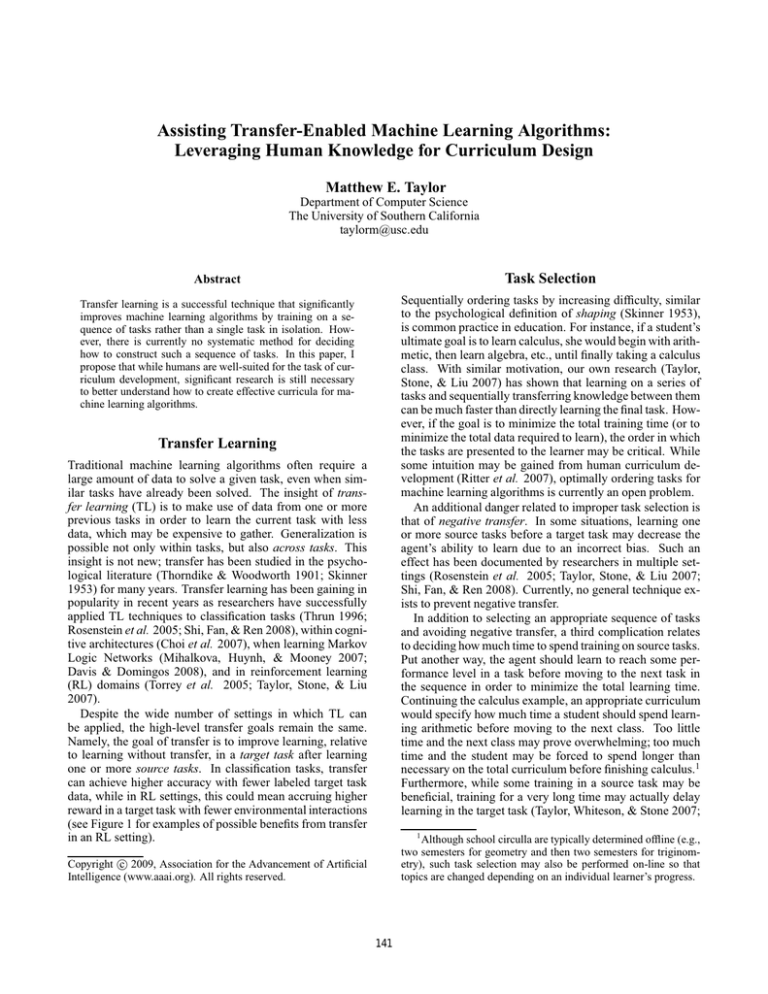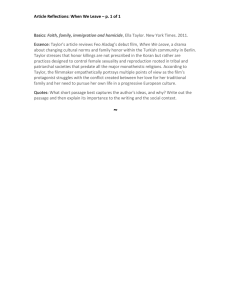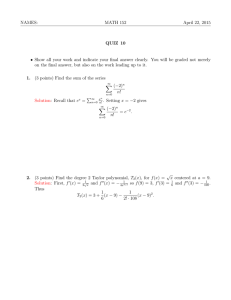
Assisting Transfer-Enabled Machine Learning Algorithms:
Leveraging Human Knowledge for Curriculum Design
Matthew E. Taylor
Department of Computer Science
The University of Southern California
taylorm@usc.edu
Abstract
Task Selection
Transfer learning is a successful technique that significantly
improves machine learning algorithms by training on a sequence of tasks rather than a single task in isolation. However, there is currently no systematic method for deciding
how to construct such a sequence of tasks. In this paper, I
propose that while humans are well-suited for the task of curriculum development, significant research is still necessary
to better understand how to create effective curricula for machine learning algorithms.
Sequentially ordering tasks by increasing difficulty, similar
to the psychological definition of shaping (Skinner 1953),
is common practice in education. For instance, if a student’s
ultimate goal is to learn calculus, she would begin with arithmetic, then learn algebra, etc., until finally taking a calculus
class. With similar motivation, our own research (Taylor,
Stone, & Liu 2007) has shown that learning on a series of
tasks and sequentially transferring knowledge between them
can be much faster than directly learning the final task. However, if the goal is to minimize the total training time (or to
minimize the total data required to learn), the order in which
the tasks are presented to the learner may be critical. While
some intuition may be gained from human curriculum development (Ritter et al. 2007), optimally ordering tasks for
machine learning algorithms is currently an open problem.
An additional danger related to improper task selection is
that of negative transfer. In some situations, learning one
or more source tasks before a target task may decrease the
agent’s ability to learn due to an incorrect bias. Such an
effect has been documented by researchers in multiple settings (Rosenstein et al. 2005; Taylor, Stone, & Liu 2007;
Shi, Fan, & Ren 2008). Currently, no general technique exists to prevent negative transfer.
In addition to selecting an appropriate sequence of tasks
and avoiding negative transfer, a third complication relates
to deciding how much time to spend training on source tasks.
Put another way, the agent should learn to reach some performance level in a task before moving to the next task in
the sequence in order to minimize the total learning time.
Continuing the calculus example, an appropriate curriculum
would specify how much time a student should spend learning arithmetic before moving to the next class. Too little
time and the next class may prove overwhelming; too much
time and the student may be forced to spend longer than
necessary on the total curriculum before finishing calculus.1
Furthermore, while some training in a source task may be
beneficial, training for a very long time may actually delay
learning in the target task (Taylor, Whiteson, & Stone 2007;
Transfer Learning
Traditional machine learning algorithms often require a
large amount of data to solve a given task, even when similar tasks have already been solved. The insight of transfer learning (TL) is to make use of data from one or more
previous tasks in order to learn the current task with less
data, which may be expensive to gather. Generalization is
possible not only within tasks, but also across tasks. This
insight is not new; transfer has been studied in the psychological literature (Thorndike & Woodworth 1901; Skinner
1953) for many years. Transfer learning has been gaining in
popularity in recent years as researchers have successfully
applied TL techniques to classification tasks (Thrun 1996;
Rosenstein et al. 2005; Shi, Fan, & Ren 2008), within cognitive architectures (Choi et al. 2007), when learning Markov
Logic Networks (Mihalkova, Huynh, & Mooney 2007;
Davis & Domingos 2008), and in reinforcement learning
(RL) domains (Torrey et al. 2005; Taylor, Stone, & Liu
2007).
Despite the wide number of settings in which TL can
be applied, the high-level transfer goals remain the same.
Namely, the goal of transfer is to improve learning, relative
to learning without transfer, in a target task after learning
one or more source tasks. In classification tasks, transfer
can achieve higher accuracy with fewer labeled target task
data, while in RL settings, this could mean accruing higher
reward in a target task with fewer environmental interactions
(see Figure 1 for examples of possible benefits from transfer
in an RL setting).
1
Although school circulla are typically determined offline (e.g.,
two semesters for geometry and then two semesters for triginometry), such task selection may also be performed on-line so that
topics are changed depending on an individual learner’s progress.
c 2009, Association for the Advancement of Artificial
Copyright Intelligence (www.aaai.org). All rights reserved.
141
better than either an algorithm with no background or a
human with no knowledge of soccer. Likewise, medical
researchers may have more accurate intuitions than a lay
person on how to best order gene classification tasks.
24
Time to Threshold
22
Performance
20
Asymptotic
Performance
Threshold
Performance
18
16
Transfer
Algorithmic Experts: Researchers familiar with the
specifics of the learning algorithm may provide further
insight into designing task sequences. Such experts may
be able to design curricula on their own, with only a
very basic understanding of the domain, or may be more
useful when their knowledge is combined with that of a
domain expert.
No Transfer
14
12
10
Jumpstart
Transfer
No Transfer
Threshold Performance
8
0
500
1000
1500
2000
2500
3000
3500
In current TL research, the person designing the curriculum is typically the TL-algorithm designer, playing the part
of all three roles. My hope is that human studies will further refine what type of backgrounds are most beneficial for
successful shaping. Such a program would likely involve
researchers from education, psychology, and machine learning. Human trials would require people with different levels of knowledge to design curricula and then test how well
the curricula enable learning improvements. Furthermore, it
may be possible to extract general principles regarding efficient curricula design by analyzing both the humans’ design
processes and the agents’ learning performances.
If shaping techniques can be improved so that relatively
little knowledge is required in practice, such techniques may
be useful even at the consumer level. For instance, it is likely
that a human could successfully select a sequence of tasks
for a learning-enabled Roomba2 so that it could learn to better vacuum his apartment due to the human’s common sense
knowledge and a background in the art of vacuuming.
One existing approach to such curriculum design is presented in the game of NERO (Stanley, Bryant, & Miikkulainen 2005), where agents train with a neuroevolutionary
technique in a series of tasks selected by a human player
(see Figure 2). People with only a limited knowledge of
the domain are able to successfully train agents to accomplish a variety of tasks. However, the authors perform no
analysis to find successful training strategies or to analyze
how increased human background knowledge may improve
agents’ performance. Games such as NERO may provide an
appropriate platform to conduct tests, or even more simple
domains may need to be developed to better isolate the key
components for successful task sequencing.
4000
Training Episodes (sample complexity)
Figure 1: Many different metrics to evaluate TL algorithms
are possible. This graph, taken from transfer results in a reinforcement learning domain (Taylor & Stone 2007), shows
some of the possible benefits of transfer to reinforcement
learning, including jumpstart, improved asymptotic performance, increased total reward (the area under a learning
curve), the reward area ratio (the ratio of the area under the
transfer to the area under the non-transfer learning curve),
and fewer training data required to reach a prespecified
threshold performance.
Torrey et al. 2008), similar to overtraining in traditional machine learning algorithms.
The Human Element
Although some work has focused on autonomous transfer
(c.f., Taylor, Kuhlmann, and Stone (2008)), the majority of
transfer work implicitly relies on humans for task selection.
My proposal is twofold: make such task selection an explicit part of the transfer process, and begin a new branch of
research specifically studying how to best design machine
learning curricula.
I envision at least three roles for human designers, each
of which requires a different amount of background knowledge:
Common Sense: Humans have a large common sense
knowledge, including facts such as “water is wet,” which
are not typically available to machine learners (Lenat
1995). For instance, when learning a soccer tasks, human knowledge about the facts that a ball can move faster
than a person and that an opponent needs to be near a ball
to take it away may be utilized to better design a task sequence.
Domain Experts: People who have experience with the domain in question will more likely be able to design better
task sequences than those without such knowledge. For
instance, someone familiar with soccer may know that
learning when to pass or when to shoot is an important
skill, and that more opponents on a field make the the
game more difficult. Such knowledge may allow the human to design a sequence of tasks for an agent which is
Figure 2: These diagrams of NERO (Stanley, Bryant, & Miikkulainen 2005) show a sequence of tasks selected by a human designer to successfully train a group of agents to engage a group of enemy agents.
2
142
www.irobot.com
Conclusion
Taylor, M. E.; Whiteson, S.; and Stone, P. 2007. Transfer via inter-task mappings in policy search reinforcement
learning. In The Sixth International Joint Conference on
Autonomous Agents and Multiagent Systems.
Thorndike, E., and Woodworth, R. 1901. The influence of
improvement in one mental function upon the efficiency of
other functions. Psychological Review 8:247–261.
Thrun, S. 1996. Is learning the n-th thing any easier than
learning the first? In Advances in Neural Information Processing Systems, 640–646.
Torrey, L.; Walker, T.; Shavlik, J. W.; and Maclin, R. 2005.
Using advice to transfer knowledge acquired in one reinforcement learning task to another. In Proceedings of
the Sixteenth European Conference on Machine Learning,
412–424.
Torrey, L.; Shavlik, J.; ad Pavan Kuppili, S. N.; and Walker,
T. 2008. Transfer in reinforcement learning via markov
logic networks. In AAAI Workshop: Transfer Learning for
Complex Tasks.
Current work has demonstrated that transfer is a viable way
to learn a sequence of tasks faster than learning directly on
a complex final task. However, the process of selecting a sequence of tasks that successfully improves learning is poorly
understood. This paper suggests that explicitly studying how
humans can form successful machine learning curricula, and
what background knowledge is necessary for them to do so,
will further our understanding of what is needed for successful transfer, as well as how to better integrate humans
into the machine learning process.
Acknowledgments
I would like to thank W. Bradley Knox, Atul Kumar, Jagrut
Sharma, and the anonymous reviewers for helpful comments
and suggestions.
References
Choi, D.; Konik, T.; Nejati, N.; Park, C.; and Langley, P.
2007. Structural transfer of cognitive skills. In Proceedings of the Eighth International Conference on Cognitive
Modeling.
Davis, J., and Domingos, P. 2008. Deep transfer via
second-order markov logic. In AAAI Workshop: Transfer
Learning for Complex Tasks.
Lenat, D. B. 1995. CYC: A large-scale investment in
knowledge infrastructure. Communications of the ACM
38(11):33–38.
Mihalkova, L.; Huynh, T.; and Mooney, R. 2007. Mapping
and revising markov logic networks for transfer learning.
In Proceedings of the 22nd AAAI Coneference on Artificial
Intelligence.
Ritter, F. E.; Nerb, J.; Lehtinen, E.; and O’Shea, T. M.
2007. In Order to Learn: How the Sequence of Topics
Influences Learning (Oxford Series on Cognitive Models
and Architectures). Oxford University Press.
Rosenstein, M. T.; Marx, Z.; Kaelbling, L. P.; and Dietterich, T. G. 2005. To transfer or not to transfer. In In
NIPS’s Workshop, Inductive Transfer: 10 Years Later.
Shi, X.; Fan, W.; and Ren, J. 2008. Actively transfer domain knowledge. In ECML-PKDD, 342–357.
Skinner, B. F. 1953. Science and Human Behavior.
Colliler-Macmillian.
Stanley, K. O.; Bryant, B. D.; and Miikkulainen, R. 2005.
Real-time neuroevolution in the NERO video game. IEEE
Transactions on Evolutionary Computation 9(6):653–668.
Taylor, M. E., and Stone, P. 2007. Cross-domain transfer
for reinforcement learning. In Proceedings of the TwentyFourth International Conference on Machine Learning.
Taylor, M. E.; Kuhlmann, G.; and Stone, P. 2008. Autonomous transfer for reinforcement learning. In The Seventh International Joint Conference on Autonomous Agents
and Multiagent Systems.
Taylor, M. E.; Stone, P.; and Liu, Y. 2007. Transfer learning
via inter-task mappings for temporal difference learning.
Journal of Machine Learning Research 8(1):2125–2167.
143



